1869: A Bengal Tiger Roams Lake George


 The Ringling Bros. and Barnum & Bailey Circus, once billed as “The Greatest Show on Earth,” ceased operation in 2017. The circus and its predecessors date to 1871.
The Ringling Bros. and Barnum & Bailey Circus, once billed as “The Greatest Show on Earth,” ceased operation in 2017. The circus and its predecessors date to 1871.
In 1869, two years before this long-running circus first opened, Campbell’s Circus and Menagerie was at Lake George when it made national and international newspaper headlines.
A Bengal tiger escaped from the circus. For a short period, the exotic feline wandered around French Mountain, just four miles from the south end of Lake George.
In the summer and autumn of 1869, Campbell’s Circus and Menagerie (later known as Campbell Bros. Circus, one of the largest circuses in America) was touring New England and New York State. In mid-September, the circus was at Lake George.
The “big top” was billed as a breathtaking show with clowns, gymnasts, jugglers, and a cornet band. There were daring horse riders, too, who displayed their equestrian skills. But the most-popular attractions were the “wild animals of all kinds.”
Early that summer, one star from the circus menagerie, an elephant, was in the middle of a road accident in Woodstock, Vermont. A horse team pulling a resident’s wagon became frightened by an elephant being paraded by its circus handlers. The buckboard collided with another horse-drawn wagon. Two women fell from the wagons, one being “severely injured.”

 In September 1869, while Campbell’s Circus and Menagerie was sequestered near Lake George, a night watchman noticed a powerful animal running from the compound and into the darkness.
In September 1869, while Campbell’s Circus and Menagerie was sequestered near Lake George, a night watchman noticed a powerful animal running from the compound and into the darkness.
It was discovered an elephant had pulled up the stake to which the pachyderm was secured. The behemoth then damaged a nearby cage allowing the occupant, a Bengal tiger, to escape into the nearby forest.
The guard scurried to the hotel where the tiger trainer was lodged. A search was organized to recapture the animal. Shortly into the pursuit, the trackers heard a calf whining. The bovine had been cornered by the tiger and was being attacked.
The tiger’s trainer, Clem King, quickly devised a plan to collar the striped cat. The escaped animal was lassoed using multiple ropes.
The carnivore was hauled back to the camp where the damaged pen had been repaired. However, when putting the animal into its cage, the iron door slammed onto the tiger’s tail injuring the beast.
The story of this incident was published in regional and national newspapers and overseas in Britain and Ireland.
Bengal tigers, originally from South Asia, are today endangered due to poaching and loss of habitat. These beautiful four-legged mammals grow to five to six feet long, three feet tall, and with a tail two to three feet long. They weigh 240–500 pounds.
Their life span is only eight to ten years. Bengal tigers have an orange-and-white body with over 100 brown and black stripes. There are only about 4,000 Bengal tigers left in the wild. In recent years, stronger conservation laws and programs have been implemented trying to insure the survival of the species.
Read more about circuses in New York State.
Illustrations, from above: A Bengal tiger (photo by Gary M. Stolz, U.S. Fish and Wildlife Service); and an 1869 advertisement for Campbell’s Circus and Menagerie published in the The Schenectady Reflector.
Source link




